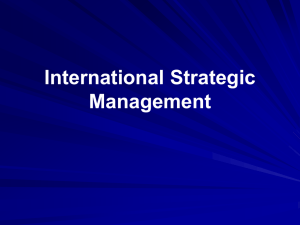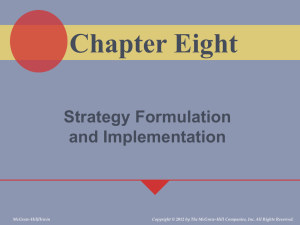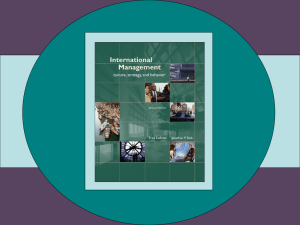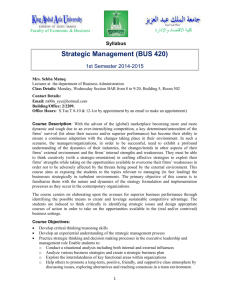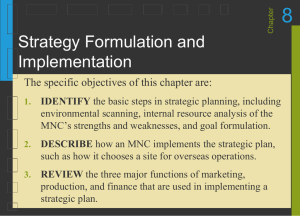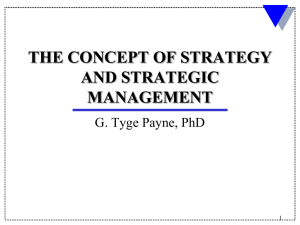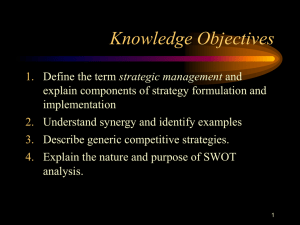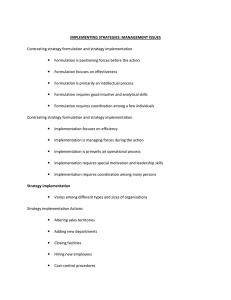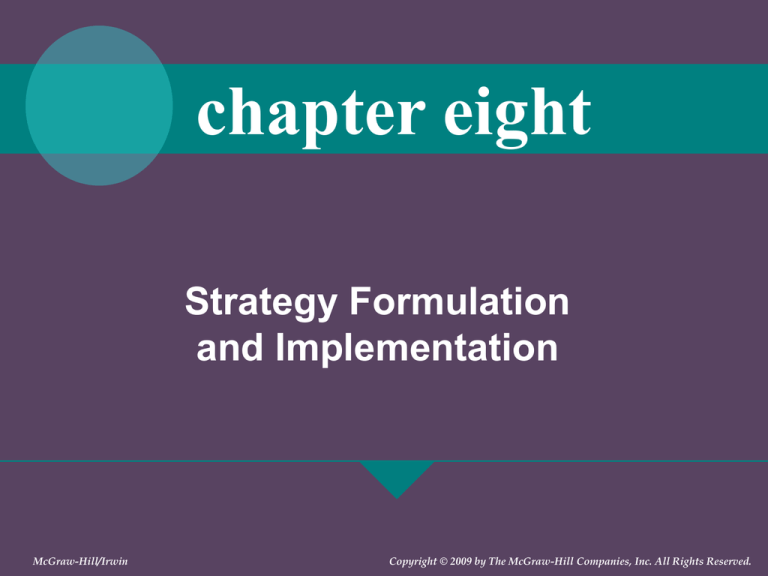
chapter eight
Strategy Formulation
and Implementation
McGraw-Hill/Irwin
Copyright © 2009 by The McGraw-Hill Companies, Inc. All Rights Reserved.
(8) Strategy Formulation
and Implementation
Chapter Objectives:
1. DISCUSS meaning, needs, benefits, approaches of
strategic planning process for MNCs
2. UNDERSTAND tension between pressures for
global integration and national responsiveness; 4
basic international strategy options
3. IDENTIFY basic steps in strategic planning
4. DESCRIBE how MNCs implement strategic plan
5. REVIEW three major functions of marketing,
production, finance used in strategic plan
implementation
6. EXPLAIN specialized strategies for emerging
markets and international new ventures
8-2
Strategic Management
• Strategic Management: the process of
determining an organization’s basic
mission and long-term objectives, then
implementing a plan of action for
pursuing the mission and attaining
objectives
8-3
Strategic Management
• Growing need for strategic
management related to increasingly
diversified operations in
continuously changing international
environment
8-4
Benefits of Strategic Planning
• 70 percent of 56 U.S. MNC subsidiaries
had comprehensive 5 to 10-year plans
according to one study
• Evidence for effectiveness of planning is
mixed. Strategic planning does not
always result in higher profitability
8-5
Benefits of strategic management
•
•
•
•
•
•
•
•
•
•
•
Establish the mission
Formulate philosophy
Establish policies
Setting objectives
Developing strategy
Plan the organizational
structure
• Provide personnel
Establish procedures
Provide facilities
Provide capital
Set standards
Establish programs and
plans
• Control information
• Activate people
6
8-6
STRATEGIC MANAGEMENT
Types Of Strategies
• Strategy
– a comprehensive plan guiding resource allocation
to achieve long-term organization goals.
• Strategic Intent
– focuses organizational energies on achieving a
compelling goal.
• Competitive Advantage
– operating in successful ways that are difficult to
duplicate
8-7
TYPES OF STRATEGIES
Corporate Strategies
• Corporate Strategy
– Sets long-term direction for the total enterprise
• Business Strategy
– Identifies how a strategic business unit or division
will compete in its product or service domain
• Functional Strategy
– Guides activities within one specific area of
operations
8-8
TYPES OF STRATEGIES
Corporate Strategies
8-9
TYPES OF STRATEGIES
Growth And Diversification Strategies
• Growth Strategy
– Expansion through current operations
• Concentration
– Expansion within an existing business area
• Diversification
– Expansion occurs by entering new business areas
• Vertical Integration
– Expansion by acquiring existing suppliers or
distributors
8-10
TYPES OF STRATEGIES
Restructuring and Retrenchment Strategies
• Retrenchment
– Changes operations to correct weaknesses
– Liquidation
• An extreme form of retrenchment wherein the business
closes and sells off its assets
• Restructuring
– Reduces the scale or mix of operations
• Downsizing
– Decreases the size of operations
• Divestiture
– Sells off part of the organization to focus on core
businesses
8-11
Steps to strategic management
•
•
•
•
•
Environmental analysis
Establish organizational direction
Strategy formulation
Strategy implementation
Strategic control
12
8-12
Environmental analysis
• Process of examining the organization’s
environment to determine:
– Strengths
– Weaknesses
– Opportunities
– Threats
13
8-13
STRATEGY FORMULATION
SWOT
• SWOT Analysis
– Identifies Organization’s Strengths, Weaknesses, Opportunities, and Threats
• Core Competency
– A special strength that gives an organization a competitive advantage
8-14
Environmental structure
• General environment
– Social, economic, political, legal, technical
• Operating environment
– International, supplier, labor, competition,
customer
• Internal environment
– Organizational, marketing, financial,
personnel, production
15
8-15
Methods of environmental forecasting
• Expert opinion
• Cross-impact analysis
• Trend extrapolation
• Multiple scenarios
• Trend correlation
• Demand/hazard
forecasting
• Dynamic modeling
16
8-16
Establish organizational direction
• Establishing an organizational direction
for the company involves determining
two indicators:
– Organizational mission – the reason why
the organization exists
– Objectives – measurable targets to track the
growth of the business
17
8-17
Key objective areas
•
•
•
•
•
•
•
•
Market standing
Innovation
Productivity
Resource levels
Profitability
Manager performance and development
Worker performance and attitude
Social responsibility
18
8-18
Types of objectives
•
•
•
•
•
•
•
Profitability
Growth
Market share
Social responsibility
Employee welfare
Product Quality
Service
•
•
•
•
•
•
19
R&D
Diversification
Efficiency
Financial stability
Resource conservation
Mgt & labor
development
8-19
Strategy formulation
• What are the purpose(s) and
objective(s) of the organization?
• Where is the organization presently
going?
• What critical environmental factors
does the organization currently face?
• What can be done to achieve
organizational objectives more
effectively in the future?
20
8-20
Growth-share matrix
22
Stars
Question Marks
20
Market Growth Rate (percent)
18
14
12
10
Dogs
Cash Cows
8
6
4
2
10.0
5.0
2.0
21
1.0
Relative Market Share
0.5
0.1
8-21
Formulating business strategies
• Structural analysis of competitive forces
– Threat of new entrants
– Bargaining power of suppliers
– Bargaining power of buyers
– Threat of substitute products
– Rivalry among existing competitors
– Strategic alternatives
22
8-22
Formulating functional strategies
• Operations strategy
• Financial strategy
• Marketing strategy
• Human resource strategy
23
8-23
Strategy implementation
• Commander approach
• Organizational change approach
• Collaborative approach
• Cultural approach
24
8-24
Commander approach
• Manager determines “best” strategy
• Manager uses power to see strategy
implemented
• Three conditions must be met
– Manager must have power
– Accurate and timely information is available
– No personal biases should be present
25
8-25
Commander approach
• Limitations
– Can reduce employee motivation and
innovation
• Advantages
– Managers focus on strategy formulation
– Works well for younger managers
– Focuses on objective rather than subjective
26
8-26
Organizational change approach
• Focuses on the organization
• Behavioral tools are used
• Includes focusing on the organization’s
staffing and structure
• Often more effective than Commander
• Used to implement difficult strategies
27
8-27
Organizational change approach
• Limitations
– Managers don’t stay informed of changes
occuring within the environment
– Doesn’t take politics and personal agendas
into account
– Imposes strategies in a “top-down” format
– Can backfire in rapidly changing industries
28
8-28
Collaborative approach
• Enlarges the Organizational Change
Approach
• Manager is a coordinator
• Management team members provide
input
• Group wisdom is the goal
29
8-29
Collaborative approach
• Advantages
– Increased quality and timeliness of
information
– Improved chances of effective
implementation
• Limitations
– Contributing managers have different
points of view and goals
– Management retains control over the
process
30
8-30
Cultural approach
• Includes lower levels of the company
• Breaks down barriers between management and workers
• Everyone has input into the formulation
and implementation of strategies
• Works best in high resource firms
31
8-31
Cultural approach
• Advantage
– More enthusiastic implementation
• Limitations
– Workers should be informed, intelligent
– Consumes large amounts of time
– Strong company identity becomes handicap
– Can discourage change and innovation
32
8-32
TYPES OF STRATEGIES
Global Strategies
• Globalization Strategy
– Adopts standardized products and
advertising for use worldwide
• Multidomestic Strategy
– Customizes advertising and products to
best fit local needs
• Transnational Strategy
– Seeks efficiencies of global operations with
attention to local markets
8-33
TYPES OF STRATEGIES
E-Business Strategies
• E-Business Strategies
– Focus on Using the Internet for Business
Transactions
• B2B Business Strategies
– use IT and Web portals to vertically link
organizations with members of their supply chains.
• B2C Business Strategies
– use IT and Web portals to vertically link
organizations with members of their customers.
8-34
STRATEGIC MANAGEMENT
Strategic Management
MODULE GUIDE 12.2
• Strategy formulation begins with the organization’s
mission and objectives.
• SWOT analysis identifies strengths, weaknesses,
opportunities, and threats.
• Porter’s five forces model examines industry
attractiveness.
• Porter’s competitive strategies model examines business
or product strategies.
• Portfolio planning examines strategies across multiple
businesses or products.
• Strategic leadership activates organizations for strategy
implementation.
8-35
STRATEGIC MANAGEMENT
Strategic Management
• Strategic management
– the process of formulating and
implementing strategies.
• Strategy Formulation
– the process of creating strategies
• Strategy Implementation
– the process of putting strategies into action.
8-36
STRATEGIC MANAGEMENT
Strategic Management
8-37
STRATEGIC MANAGEMENT
Strategy Formulation
• Mission Statement
– The reason for the organizations existence in
society
• Operating Objectives
– Specific results that organizations attempt to
achieve
Common Operating Objectives of Organizations
•Profitability
•Market share
•High-quality workforce
•Cost efficiency
•Product and service quality
•Innovativeness
•Social responsibility
8-38
STRATEGY FORMULATION
SWOT
• SWOT Analysis
– Identifies Organization’s Strengths, Weaknesses, Opportunities, and Threats
• Core Competency
– A special strength that gives an organization a competitive advantage
8-39
STRATEGY FORMULATION
Porter’s Five Forces
8-40
STRATEGY FORMULATION
Porter’s Five Forces
• Porter’s Competitive Strategies
– Differentiation Strategy
• Offers products and services that are uniquely different
from the competition
– Focused Differentiation Strategy
• offers a unique product to a special market segment.
– Cost Leadership Strategy
• Seeks to operate at lower costs than competitors
– Focused Cost Leadership Strategy
• uses cost leadership and target needs of a special market.
8-41
STRATEGY FORMULATION
Porter’s Five Forces
COMPETITIVE ANALYSIS
8-42
STRATEGY FORMULATION
Boston Consulting Group (BCG)
• BCG Matrix
– Analyzes business opportunities according to
growth rate and market share
8-43
STRATEGIC MANAGEMENT
Strategy Implementation
• Strategic Leadership
– the capability to inspire people to
successfully engage in a process of
continuous change, performance
enhancement, and implementation of
organizational strategies.
8-44
Approaches to Strategic Planning
1.
2.
3.
4.
Economic Imperative
Administrative Coordination
Political Imperative
Quality Imperative
8-45
(1) Economic Imperative:
• Economic imperative focused MNCs employ
worldwide strategy based on cost leadership,
differentiation, and segmentation
• Strategy also used when product is regarded
as generic and therefore is not sold on name
brand or support service
• Often sell products for which large portion of
value is added in upstream activities of
industry value chain
– Research and development
– Manufacturing
– Distribution
8-46
(2) Political Imperative
• MNCs using political imperative are countryresponsive; approach designed to protect local
market niches
• These MNCs often use country-centered or
multi-domestic strategy
• Success of product or service depends heavily
on
– Marketing
– Sales
– Service
8-47
(3) Quality Imperative
• Quality imperative has 2 paths
– Change in attitudes and raising of
expectations for service quality
– Implementation of management practices
designed to make quality improvement an
ongoing process
• TQM Total Quality Management (see
next slide)
8-48
Total Quality Management
• Cross-train personnel to do jobs of all members in work
group
• Process re-engineering designed to help
identify/eliminate redundant tasks
• Reward system designed to reinforce quality
performance
• Quality operationalized by meeting or exceeding
customer expectations
• Quality strategy formulated at top management level
and diffused through organization
• TQM techniques: traditional inspection and statistical
quality control; cutting edge Human Resource
Management techniques such as self-managing teams
and empowerment
8-49
(4) Administrative Coordination
Imperative
• MNC makes strategic decisions based
on merits of individual situation rather
than predetermined economic or political
strategy
• Least common approach to formulation
and implementation of strategy
• Many large MNCs work to combine all 4
of the approaches to strategic planning
8-50
Global vs. Regional Strategies
• Fundamental Tension: The globalization vs.
national responsiveness conflict.
• Global integration: Production and
distribution of products and services of a
homogenous type and quality on a worldwide
basis
• National responsiveness: need to
understand different consumer tastes in
segmented regional markets and respond to
different national standards and regulations
imposed by autonomous governments and
agencies
8-51
Global Integration vs.
National Responsiveness
8-52
Summary:
Approaches to Strategic Planning
• Appropriateness of each strategy depends on
pressures for cost reduction and local
responsiveness in each country served:
• Global strategy is low-cost strategy
attempting to benefit from scale economies in
production, distribution, marketing
• Transnational strategy pursued when high
cost pressures and high demand for local
responsiveness
8-53
Basic Elements in Strategic Planning
for International Management
8-54
Elements of Strategic Planning:
Environmental Scanning
8-55
Elements of Strategic Planning:
Environmental Scanning
• Provides management with accurate
forecasts of trends relating to external
changes in geographic areas where firm
is doing business or considering doing
business
• Changes relate to economy, competition,
political stability, technology,
demographic and consumer data
8-56
Elements of Strategic Planning:
Internal Resource Analysis
• Evaluate MNC’s current managerial, technical,
material, and financial strengths and
weaknesses
– Assessment then used to determine ability to take
advantage of international market opportunities
– Match external opportunities (gained in
environmental scan) with internal capabilities
(gained through internal resource analysis)
– Key question for MNC: Do we have the people and
resources that can help us develop and sustain
necessary Key Success Factors, or can we acquire
them?
8-57
Elements of Strategic Planning:
Strategic Planning Goals
• Goal formulation often precedes first two steps
(environmental scanning, internal analysis)
• More specific goals for strategic plan come
from external scan and internal analysis
– Goals serve as umbrella beneath which
subsidiaries and other international groups operate
– Profitability and marketing goals almost always
dominate strategic plans
– Once set strategic goals, MNC develops specific
operational goals and controls for subsidiary or
affiliate level
8-58
Elements of Strategic Planning:
Implementation
• Provides goods and services in accord with
plan of action
• Plan often will have overall philosophy or
guidelines to direct process
• Considerations in selecting country:
– Advanced industrialized countries offer largest
markets for goods/services
– Amount of government control
– Restrictions on foreign investment
– Specific benefits offered by host countries
8-59
Elements of Strategic Planning:
Implementation (continued)
• Local issues
– Once country has been decided, firm must
choose specific locale
– Important factors influence this choice:
• Access to markets
• Proximity to competitors
• Availability of transportation and electric
power
• Desirability of location for employees
coming in from outside
8-60
Elements of Strategic Planning:
Implementation (continued)
• Production
– When exporting goods to foreign market,
production has usually been handled through
domestic operations
– More recently MNCs have found that whether they
export or produce goods locally in host country,
consideration of worldwide production is important
– Recent trend away from multi-domestic approach
and toward global coordination of operations
8-61
Elements of Strategic Planning:
Implementation (continued)
• Finance
– Transfer funds from once place in world to another,
or borrowing funds in international money markets
often less expensive than relying on local sources
– Issues include
• Reevaluation of currencies
• Privatization
• Strategic issues for base of pyramid
• International new ventures and “born global”
firms
8-62
Elements of Strategic Planning:
Implementation (continued)
• Strategies for “base of pyramid” (BOP)
– Emerging market customers
– People at bottom of economic pyramid
– Marketing at BOP forces consideration of
smaller-scale strategies
• International new venture and “bornglobal” firms
8-63
Elements of Strategic Planning:
Implementation (continued)
• International new ventures and “born-global”
firms
– Firms that engage in significant international activity
a short time after being established
– Successful born-global firms leverage a distinctive
mix of orientations and strategies
• Global technological competence
• Unique product development
• Quality focus
• Leveraging of foreign distributor competencies
8-64
Formulation of MNC Goals
8-65
The Role of Functional Areas
in Implementation
• Production
– Traditionally handled through domestic operations
– Increasingly consideration of world wide production
is important
– Recent trend away from scattered approach and
toward global coordination of operations
– If product labor intensive, farm out product to lowcost sites (e.g., Mexico)
• Marketing
– country-by-country basis
– built around well-known 4 P’s (product, price,
promotion, place)
8-66
The Role of Functional Areas
(continued)
• Finance
– Normally developed at home office
– Carried out by overseas affiliate or branch
– MNCs have learned that transferring funds
from one place in world to other, or
borrowing funds in international money
markets often less expensive than reliance
on local sources
– Major headache is reevaluation of
currencies
8-67
Specialized Strategies
• Some circumstances may require
specialized strategies:
– Strategies for developing and emerging
markets
– Strategies for international entrepreneurship
and new ventures
8-68
Strategies for Emerging Markets
• The big emerging markets: Mexico, Brazil Argentina,
South Africa, Poland, Turkey, India, Indonesia, China,
South Korea
• These nations have captured the bulk of investment
and business interest from MNCs and their managers
in recent years.
• Emerging markets present exceptional risks due to
political and economic volatility. These risks show up
in corruption, failure to enforce contracts, red tape and
bureaucratic costs, and general uncertainty in legal
and political environment.
8-69
Two Unique Strategies for
Emerging Markets
•
•
First Mover Strategies: significant economies associated with early
entry and first-mover positioning
– May be a narrow window of opportunity within which these
opportunities can be best exploited.
Strategies for Base of Pyramid (BOP): 4-5 billion potential customers
around the globe heretofore ignored by global business
– BOP forces global business to rethink their strategies. Must consider
relationships with local governments, small entrepreneurs, and
nonprofits rather than depend on established partners such as
central government.
– BOP strategies challenging to implement
– Represents opportunity to incubate new, leapfrog technologies
– Successful BOP strategies can travel profitably to higher income
markets
8-70
The World Population and
Income Pyramid
8-71
(2) Entrepreneurship Strategy and
New Ventures
• Increasingly small and medium size
enterprises, often in the form of new ventures,
are becoming involved in international
management.
• The earlier in its existence an innovative firm
internationalizes, the faster it is likely to grow
both overall and in foreign markets.
• Venture performance (growth and ROE) is
improved by technological learning gained
from international environments.
8-72
International Entrepreneurship
• Defined as “a combination of innovative
proactive, and risk-seeking behavior that
crosses national borders and is intended
to create value in organizations”
8-73
International New Ventures and
“Born Global” Firms
• “Born global”: firms that engage in significant
international activity a short time after being
established.
• Most important business strategies employed
by born global firms are global technological
competence, unique products development,
quality focus, and leveraging of foreign
distributor competencies.
• Truly born global firms tend to survive longer
than other seemingly global companies.
8-74
Global Management Team
• Transnational companies have global management
teams because they realize the need for a world view at
the level of top management.
• A management team too heavily dominated by one
country will not have a true global view.
• Input from top managers from all countries
• A good example is Imperial Chemical Industries (ICI),
whose 16-person board was all British until 1982. It now
includes two Americans, one Canadian, one Japanese,
and one German; 35 percent of the top 180 people are
non-British.
8-75
Global management training.
• Transnational companies realize that a global culture is
needed to compete around the world.
• A company cannot attain such a culture without
integrating managers from other countries into the
system.
• Cross-country training and travel are necessary to allow
managers and employees to be comfortable in the triad
cultures.
• GE adapted what it calls a Global Leadership Program.
Over a period of ten months, the top 55 people from its
U.S., European, and Japanese medical equipment
businesses met once on each continent and in Japan
for several days at a time.
8-76
Global travel and assignments.
• The key to becoming a global power is to manage by walking
around (MBWA) the world.
• Top managers cannot understand other cultures unless they
spend substantial time in those countries regularly.
• Too many companies have top managers travel abroad, or bring
managers to headquarters, only as a ceremonial show.
• To develop global products, designers and product managers
cannot rely on market research data alone.
• American designers will have limited ability to create innovate
home and office furniture for sale in Europe and Japan if they
have never seen homes and offices in these countries. Another
way to train people to think globally is to move them across
national boundaries.
8-77
Global Strategy
• To be successful in the world market, global firms must
pit all their resources against competitors in a highly
integrated way.
• They must have a centralized global strategy, with
various aspects of operations decentralized as
economics and effectiveness dictate.
• Transnational companies seek to respond to particular
local market needs while avoiding a compromise of
efficiency of the overall global system.
• Successful transnational companies have one global
strategy, not separate strategies for each country or
profit center.
8-78
Global coalitions.
• The difficulties of gaining access to foreign markets and in
surmounting scale and learning thresholds in production,
technology, and other activities have led many firms to
work cooperatively among themselves.
• Penetrating the global market requires coalitions; the go-italone approach is ineffective in the world arena.
• Coalitions include a wide variety of arrangements, such as
swapping of new' products and models, licenses, supply
agreements, and cooperative R&D efforts.
• Many companies in the automobile, aircraft, robotics,
consumer electronics, pharmaceutical, and semiconductor
industries have developed complex coalitions to
compensate for market share weakness in key nations, fill
market niches, and produce global products.
8-79
Global parochialism.
• To go global, companies must overcome
parochial attitudes, particularly the "notinvented-here" syndrome.
• Managers must search the world, not
just their home country, for the best
people, technology, and costs.
• For example, four of ICI's nine business
units are headquartered outside Britain.
8-80
Global Operations and Products
• Multinational companies have major operating facilities
throughout the globe to gain market access and for
cost advantage.
• They have "good citizen" images around the world.
Transnational realize that a local presence decreases
political and exchange rate risks.
• Export firms are often perceived as invaders.
• They face protectionism and import restrictions and
find the doors to markets closed.
• A true insider will remain viable in the country while
fellow country export companies are excluded.
8-81
Global design and product process.
• Transnational companies centralize product design to
develop global products.
• The production process is standardized worldwide to
ensure economies of scale.
– A Whirlpool study revealed that appliances all over the world,
despite differences in consumer preferences, are basically alike in
their working components.
– Based on that study, Whirlpool is designing global products using
components supplied by different international sources, with minor
changes for local preferences.
• Ideas for improvements from country operations are
shared globally to benefit the entire company.
8-82
Global Technology and R&D
• Transnational companies realize that their success
depends upon technology and R&D.
• Such companies do not adhere to the not-inventedhere mentality.
• They know that fewer than 50 percent of the world's
technological innovations can legitimately lay claim to
the "Made in America" slogan (down from 80 percent
in the 1950s). Instead, they go to the place in the
world that can do the best job.
• When conducting R&D, transnational companies focus
on global, not local, products.
8-83
Global Financing
• Global parochialism also extends to financing.
• Multinational organizations search world markets
to get the best rates and terms for long-term
financing.
– Texas Instruments has manufacturing plants in
Taiwan, Malaysia, and Japan, where interest
rates are half those in the United States,
thereby allowing TI to cut capital costs.
• Short term financing is done largely in individual
countries using local financial institutions.
8-84
Global Marketing
• Transnational companies view North America, Europe,
and Japan as one world market, rather than three.
• They accentuate the similarities of human beings across
the global triad, rather than emphasize differences.
• With comparable income levels, education levels,
academic and cultural background, lifestyles, and
access to information and travel, Americans,
Europeans, and Japanese are becoming more and
more alike.
• Because of global similarities, many products do not
need to be localized at all, or need only minor changes
to satisfy taste differences.
8-85
Global products with local
adaptations.
• Some transnational companies develop global products but
adapt them to the needs of local markets.
• The changes a product needs to undergo for local markets
vary.
• Consumer products used in the home, such as Nestle's soups
and frozen foods, tend to be more culture-bound than products
used outside the home, such as automobiles and credit cards.
• Industrial products, such as personal computers, are inherently
less culture bound than consumer products.
• Experience also suggests that products are less culture-bound
if they are used by young people whose cultural norms are not
ingrained, people who travel in different countries, and egodriven consumers who can be appealed to through myths and
fantasies shared across cultures.
8-86
Global introduction of products.
• Transnational companies introduce new products
simultaneously throughout the world.
• Many companies have learned the hard way that introducing a
product in one country and then bringing it to another country
limits global success.
• When an American company introduces a product in the U.S.,
the Japanese are watching.
• They can quickly copy the product and introduce it in Japan and
other countries before the American company can, causing the
American company to lose its leadership position.
• Gillette formally introduced its Sensor razor during the 1990
Super Bowl in America; soon after it took the product to 19
counties simultaneously, using virtually the same commercial.
8-87
Review and Discuss
1.
2.
3.
4.
5.
Of the four imperatives, which is most important to
IBM’s effort to enter the Pacific Rim Market?
Define global integration as used in the context of
international strategic management?
Are globalization and national responsiveness
diametrically opposed?
Anheuser-Busch is attempting to enter India, where
beer is hardly consumed and liquor dominates the
market. What areas should be targeted for strategic
goals? What are some marketing implications here?
What conditions have allowed some firms to be
“born global”?
8-88

